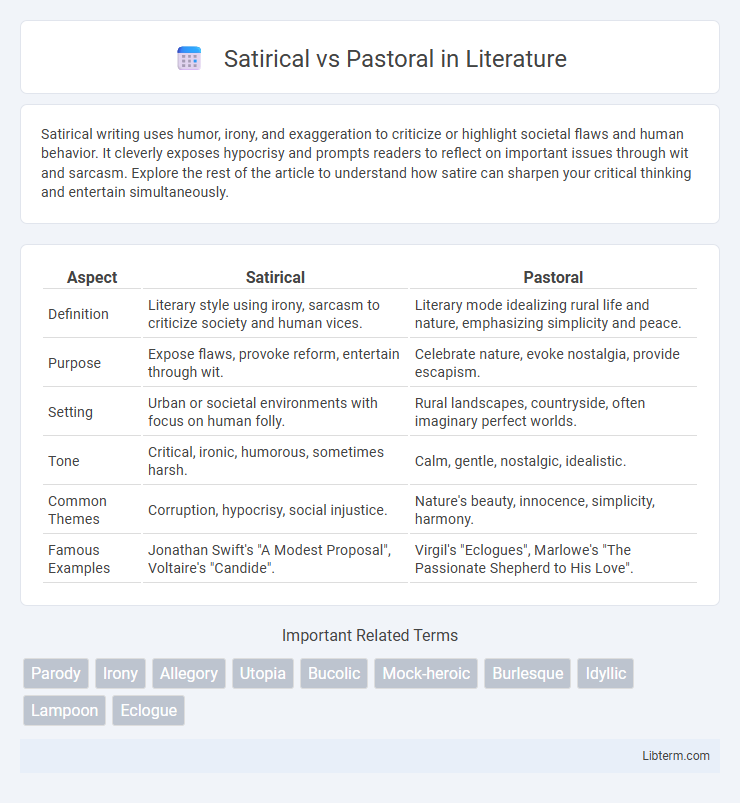Satirical writing uses humor, irony, and exaggeration to criticize or highlight societal flaws and human behavior. It cleverly exposes hypocrisy and prompts readers to reflect on important issues through wit and sarcasm. Explore the rest of the article to understand how satire can sharpen your critical thinking and entertain simultaneously.
Table of Comparison
| Aspect | Satirical | Pastoral |
|---|---|---|
| Definition | Literary style using irony, sarcasm to criticize society and human vices. | Literary mode idealizing rural life and nature, emphasizing simplicity and peace. |
| Purpose | Expose flaws, provoke reform, entertain through wit. | Celebrate nature, evoke nostalgia, provide escapism. |
| Setting | Urban or societal environments with focus on human folly. | Rural landscapes, countryside, often imaginary perfect worlds. |
| Tone | Critical, ironic, humorous, sometimes harsh. | Calm, gentle, nostalgic, idealistic. |
| Common Themes | Corruption, hypocrisy, social injustice. | Nature's beauty, innocence, simplicity, harmony. |
| Famous Examples | Jonathan Swift's "A Modest Proposal", Voltaire's "Candide". | Virgil's "Eclogues", Marlowe's "The Passionate Shepherd to His Love". |
Defining Satirical and Pastoral Literature
Satirical literature employs irony, sarcasm, and wit to criticize societal flaws, human vices, and political corruption, often aiming to provoke change or reflection. Pastoral literature idealizes rural life and nature, depicting simple, peaceful landscapes and shepherds as symbols of innocence and harmony. Both genres contrast urban or corrupt environments, but satire targets flaws through mockery, while pastoral celebrates virtue through idyllic representation.
Historical Origins and Evolution
Satirical literature originated in ancient Greece and Rome, with writers like Aristophanes and Juvenal using humor and irony to criticize social and political issues, evolving through the Renaissance and Enlightenment as a tool for reform. Pastoral literature traces back to Theocritus and Virgil, idealizing rural life and nature as a contrast to urban complexity, reflecting changing societal values from antiquity through the Romantic era. Both genres adapted to historical contexts, with satire responding to corruption and power, while pastoral evolved to express nostalgia and critique industrialization.
Key Characteristics of Satire
Satire employs wit, irony, and exaggeration to criticize human follies and societal vices, aiming to provoke change or reflection. It often features a sharp tone and targets political, social, or cultural issues through humor or sarcasm. Satirical works use parody, caricature, and hyperbole as key tools to expose hypocrisy and absurdity.
Hallmarks of Pastoral Works
Pastoral works are characterized by an idealized portrayal of rural life, emphasizing simplicity, harmony with nature, and the innocence of shepherds or rustic characters. These narratives often feature bucolic landscapes, peaceful settings, and themes of escape from the complexities of urban or court life. Unlike satirical works that critique society through irony and humor, pastoral literature celebrates an idyllic natural world and human connection to it.
Major Themes Explored
Satirical literature explores themes like social criticism, hypocrisy, and human folly, using humor and irony to expose flaws in society and provoke change. Pastoral works focus on themes of nature, simplicity, and idealized rural life, celebrating harmony between humans and the natural world. Both genres reflect contrasting views on human experience, with satire emphasizing societal dysfunction and pastoral highlighting tranquility and innocence.
Famous Examples in Literature
Jonathan Swift's "Gulliver's Travels" exemplifies satire through its sharp critique of human nature and society, using irony and exaggeration to expose flaws. In contrast, pastoral literature like Christopher Marlowe's "The Passionate Shepherd to His Love" idealizes rural life, portraying nature as a serene escape from urban complexity and corruption. These distinct approaches highlight how satire confronts societal issues, while pastoral celebrates simplicity and harmony with the natural world.
Techniques and Literary Devices Used
Satirical literature employs irony, sarcasm, and exaggeration to criticize societal flaws, often using parody and hyperbole to expose human vices and follies. Pastoral works utilize idealization, symbolism, and imagery to depict rural life as peaceful and harmonious, frequently embracing allegory and metaphor to contrast the innocence of nature with the corruption of urban existence. Both genres rely on vivid characterization and tone, but satire leans toward cynicism and social commentary, while pastoral emphasizes nostalgia and simplicity.
Influence on Modern Literature
Satirical literature, characterized by its critical and humorous examination of society's flaws, has profoundly shaped modern literature by encouraging writers to address social and political issues with wit and irony. Pastoral literature, with its idealized depictions of rural life and nature, continues to influence contemporary works that explore themes of simplicity, nostalgia, and escape from urbanization. Both genres contribute to modern literary diversity by offering contrasting perspectives on human experience and societal values.
Satirical vs Pastoral: Comparative Analysis
Satirical literature uses humor, irony, and exaggeration to criticize societal flaws, while pastoral literature idealizes rural life and nature, emphasizing simplicity and tranquility. Satirical works often depict urban or corrupt environments to highlight moral failings, contrasting with pastoral texts that romanticize the countryside as an escape from complexity. The comparative analysis reveals how satire confronts social issues through critique, whereas pastoral seeks to evoke harmony and nostalgia for a perceived natural order.
Contemporary Relevance and Adaptations
Satirical and pastoral genres remain relevant in contemporary literature through diverse adaptations that address modern societal issues and environmental concerns. Satirical works use humor and irony to critique political systems and cultural norms, as seen in contemporary novels, films, and digital media. Pastoral adaptations often highlight ecological awareness and nostalgia for rural life, influencing environmental activism and artistic expressions in urbanized settings.
Satirical Infographic

 libterm.com
libterm.com